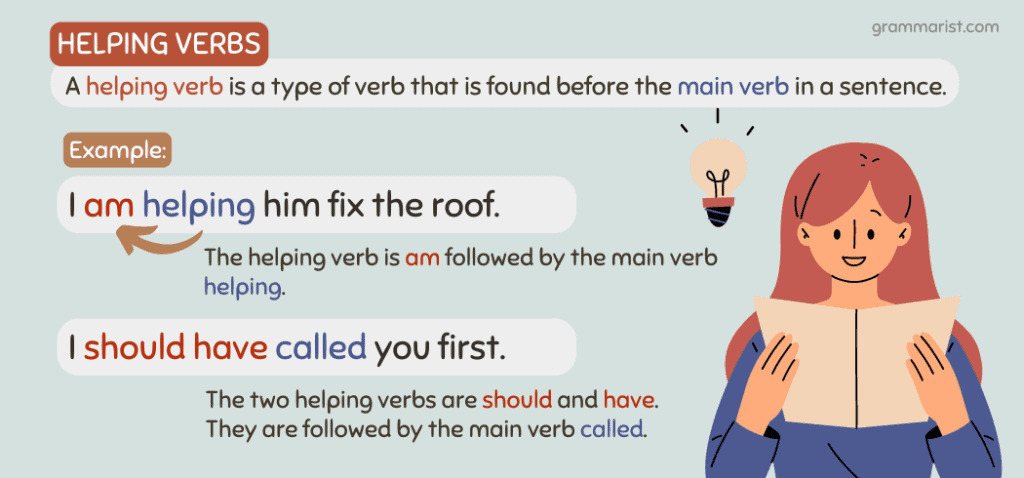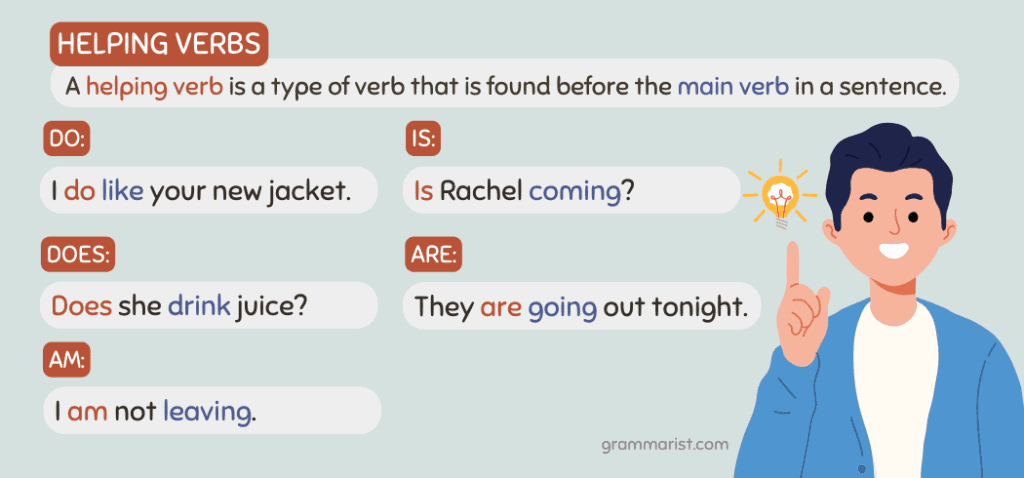The most common helping verbs are do, does, am, is, and are. Let’s talk about when to use these six helping verbs in sentences.
What Are Helping Verbs?

In English grammar, a helping verb is a type of verb that is found before the main verb in a sentence. For example:
- I am helping him fix the roof.
In this sentence, the helping verb is am followed by the main verb helping.
You can find more than one helping verb in a sentence. For example:
- I should have called you first.
Here, the two helping verbs are should and have. They are followed by the main verb called.
When to Use Do, Does, Am, Is & Are

The helping verbs do, does, am, is, and are follow different grammar rules based on the verb tense.
Examples of When to Use Do in Sentences
The rules on when to use do and does can be confusing. But we use do when the subject is I, you, or in plural form. This auxiliary verb is also used in the present simple tense.
In its emphatic form, do gives extra force to the main verb. For example:
- I do like your new jacket. (Do as the helping verb and like as the main verb)
We can also use do in question sentences. For example:
- Do you eat waffles? (Do as the helping verb and eat as the main verb)
Do is also used in the negative form with the word not. Its contracted form is don’t. For example:
- I don’t want to move to a new city. (Do as the helping verb and want as the main verb)
Examples of When to Use Does in Sentences
Does is also in the present simple tense used with a singular subject except I and you. Like do, we can use does in emphatic, negative, and question forms. For example:
- Emphatic form: She does love diamonds (Does as the helping verb and love as the main verb)
- Question form: Does she drink juice? (Does as the helping verb and drink as the main verb)
- Negative form: Taylor does not play the violin. (Does as the helping verb and play as the main verb)
Examples of When to Use Am in Sentences
Am is the helping verb that refers to “to be” when the subject is I. It’s followed by the main verb in the present participle to form the present continuous form of the verb. For example:
- Affirmative form: I am washing the dishes. (Am as the helping verb and washing as the main verb)
- Question form: Am I seeing things you don’t see? (Am as the helping verb and seeing as the main verb)
- Negative form: I am not leaving. (Am as the helping verb and leaving as the main verb)
Examples of When to Use Is in Sentences
Use is when the subject is in the third-person singular. It’s followed by the main verb in the present participle to form the present continuous form of the verb. For example:
- Affirmative form: She is cooking soup. (Is as the helping verb and cooking as the main verb)
- Question form: Is Rachel coming? (Is as the helping verb and coming as the main verb)
- Negative form: He is not writing the article. (Is as the helping verb and writing as the main verb)
Examples of When to Use Are in Sentences
Use are when the subject is in second-person singular or third-person plural. It’s followed by the main verb in the present participle to form the present continuous form of the verb. For example:
- Affirmative form: They are going out tonight. (Are as the helping verb and going as the main verb)
- Question form: Are you seeing someone else? (Are as the main verb and seeing as the main verb)
- Negative form: We are not talking. (Are as the main verb and talking as the main verb)
Practice Using Helping Verbs
Helping verbs extend the meaning of the main verb to convey the time of action in the sentence. My guide’s shown you how to use the most common helping verbs: do, does, am, is, and are.
Remember what I said to use does and is for third-person singular subjects, am for the subject I, and do and are for first-person, second-person, and third-person plural subjects.